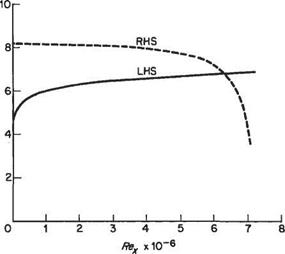Transition prediction
The usual methods of determining the transition point are based on the so-called e" method developed by A. M.O. Smith and H. Gamberoni (1956) at Douglas Aircraft Co.[48] These methods are rather complex and involve specialized computational techniques. Fortunately, Smith and his colleagues have devised a simple, but highly satisfactory alternative.* They have found on a basis of predictions using the e" method that the transition Reynolds number Rext (where Rex = Uex/v) is related to the shape factor Я by the following semi-empirical formula:
log10(Re#) = -40.4557 + 64.8066Я – 26.7538Я2 + 3.3819Я3 2.1 < Я < 2.8
(7.130)
To use this method log10 (Rex) is plotted against x (distance along the surface from the fore stagnation point on the leading edge). A laminar boundary-layer calculation is carried out and the right-hand side of Eqn (7.130) is also plotted against x. Initially, the former curve will lie below the latter; the transition point is located at the value of x (or Rex) where the two curves first cross. This is illustrated in Fig. 7.46
|
|
Fig. 7.46
where the left-hand side (denoted by LHS) and the right-hand side (denoted by RHS) of Eqn (7.130), calculated for the case of the circular cylinder illustrated in Fig. 7.45, are plotted against Rex. In this case, the two curves cross at a value of Rex — 6.2 x 106 and this is taken to correspond to the transition point.













